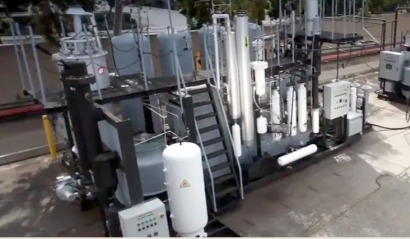
The project will help solve two major challenges in California: reducing the risk of catastrophic wildfires and decarbonizing transportation.
These challenges will be mitigated by removing the dead, dying, and diseased trees that can become fuel for forest-fires, and converting it into carbon negative UltraGreen Hydrogen™ and biocarbon using Kore’s proprietary technology.
The California Department of Conservation has awarded Kore a $500,000 grant under the Forest Biomass to Carbon-Negative Biofuels Pilot Program to develop the project.
Stantec is leading the development of the Conceptual Engineering, to be followed by the Front End Engineering Design, the last quarter of this year. Construction is expected to begin by early-2024, with commercialization achieved by the second half of 2025.
Unfortunately, wildfires have become all too common in California, propelled by a changing climate and insufficient forest management practices. The frequency and magnitude of wildfires has caused two of the largest insurance companies in the country to discontinue writing policies in California.
This project is a step in the right direction to improve the health of California forests, reduce wildfires, and decarbonize transportation by implementing Kore’s innovative solution.
“Given the recent record-breaking global temperatures, innovative solutions to ease the effect of climate change are crucial," said Cornelius Shields, Founder and CEO, Kore Infrastructure.
“We are proud to partner with the Indigenous leaders at Tule River Economic Development Corporation to introduce our unique technology that can mitigate wildfire risk and restore the health of Sierra Nevada forests, enhance climate resiliency, encourage energy independence, and help decarbonize transportation in the state of California.”
The project will remove and process 48 tons per day of non-merchantable dead dying, and diseased trees, which will help reduce wildfire risk. The Tule River Economic Development Corporation currently manages 57,000 acres of Sierra Nevada Forest and is entering into a joint stewardship agreement with the US Forest Service to manage another 325,000 acres.
Orchard wood waste from the Central Valley will provide Kore’s facility with supplemental feedstock when forest access is unavailable due to weather or other adverse conditions.
Dennis Ickes, CEO of Tule River Economic Development Corporation said, “We are thrilled to collaborate with Kore Infrastructure to support and scale the vision of our renewable energy campus with the production of carbon-negative hydrogen that sustains our local economy. This project will improve the health of the forests we manage, generate renewable energy, and help enhance the economic independence of our community.”
The project will generate two metric tons of fuel cell quality hydrogen (99.999% purity) per day. Kore’s commercial partner intends to use this hydrogen to decarbonize shipping container handling equipment at the ports of Los Angeles and Long Beach by converting diesel-powered equipment into fuel cell electric.
The hydrogen may also be available to local users as demand for fuel cell quality hydrogen expands geographically. Fuel cell electric vehicles (FCEV) are also being considered for feedstock, hydrogen, and biocarbon transport to further reduce the project’s carbon intensity.
The project will also produce about 10 tons of biocarbon daily – an elemental carbon co-product with multiple benefits. As a soil amendment, biocarbon increases plant yield while reducing irrigation and fertilizer needs. Biocarbon also sequesters about three tons of carbon dioxide for every ton incorporated into the soil.
With a heating value comparable to fossil coal, biocarbon can also be used to decarbonize difficult to abate industries such as cement manufacturing, which accounts for four percent of California’s greenhouse gas (GHG) emissions.
David Shabazian, Director of California Department of Conservation said, “We congratulate Kore and look forward to our ongoing collaboration. Converting forest biomass waste into carbon-negative energy is a critical part of achieving California’s climate goals while reducing wildfire hazards, improving watersheds and supporting sustainable local economies in the region.”
Further commending the project, Fiona Ma, California State Treasurer said, “Congratulations to Kore Infrastructure on their partnership with the Tule River Economic Development Corporation and California Department of Conservation.
"Kore’s technology will convert deadwood from wildfire-prone areas into carbon-negative energy, helping solve two of California’s most pressing challenges: the devastating effects of wildfires and decarbonizing transportation.”
Today’s announcement marks the first phase of a project that is being master planned to triple in size in order to scale its benefits for climate adaptation, carbon reduction, and increased energy independence for local communities. Kore’s model is being closely considered and evaluated for replication by the Central Valley Orchard and Forest Management for several projects throughout the Central Valley.

